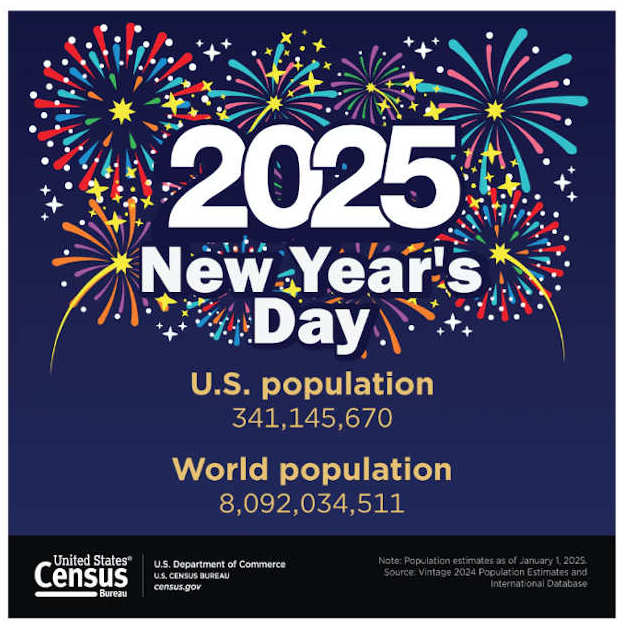
As 2024 came to a close, the U.S. Census Bureau projected the U.S. population would be 341,145,670 on New Year’s Day, an annual increase of 2,640,171 or 0.78%.
By comparison, just before the nation’s independence nearly 250 years ago, the 13 colonies had about 2.5 million residents.
The projected world population on Jan. 1, 2025, is 8,092,034,511, up 71,178,087 (0.89%) from New Year’s Day 2024.
During January 2025, 4.2 births and 2.0 deaths are expected worldwide every second.
Population estimates from U.S. and world population clocks
The Census Bureau’s Population Clock displays simulated real-time growth of the U.S. and world populations.
The U.S. Population Clock shows the population by age (0 to 100+) and sex, as well as the highest-density states, counties and cities.
In January 2025, the United States is expected to experience one birth every 9.0 seconds and one death every 9.4 seconds. Net international migration is expected to add one person to the U.S. population every 23.2 seconds.
The combination of births, deaths and net international migration increases the U.S. population by one person every 21.2 seconds.
The World Population Clock shows the most populous countries and the top U.S. export and import partners.
How does the Census Bureau population clock work?
At the end of each year, the Census Bureau uses a revised series of population estimates to update the short-term projections for the population clock.
Once the updated monthly projections are completed, daily population clock values are derived by interpolation.
Within each calendar month, the daily numerical population change is assumed to be constant, subject to negligible differences caused by rounding.
World population projections
The Census Bureau’s International Database, or IDB, created in the 1960s now produces population projections for 227 countries and equivalent areas, plus 16,919 subnational areas.
Population size (by single year of age and sex) and components of change (fertility, mortality and migration) are available for each calendar year through 2100.
The IDB was last updated in November and is set to be updated again next November. The United States is expected to remain the world’s third most populous country in 2025.
As of July 2024, the top 10 most populous countries were India (1,409,128,296); China (1,407,929,929); the United States (336,673,595); Indonesia (281,562,465); Pakistan (252,363,571); Nigeria (236,747,130); Brazil (220,051,512); Bangladesh (168,697,184); Russia (140,820,810); and Mexico (130,739,927).
Diana M. Rodriguez is a senior communications specialist in the Census Bureau’s Communications Directorate.

 How to resolve AdBlock issue?
How to resolve AdBlock issue? 



